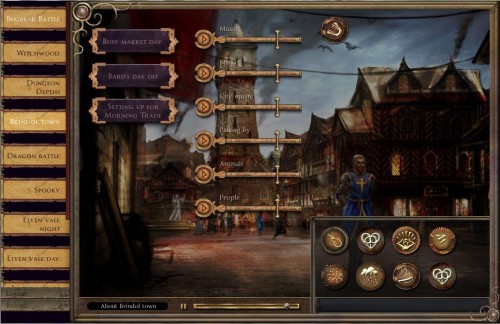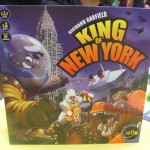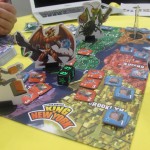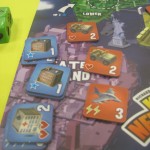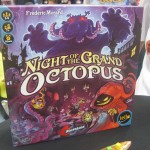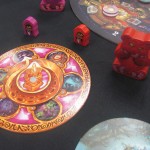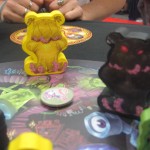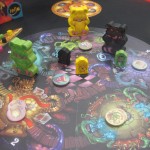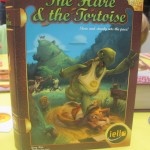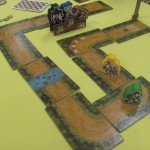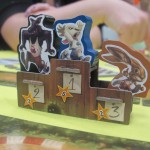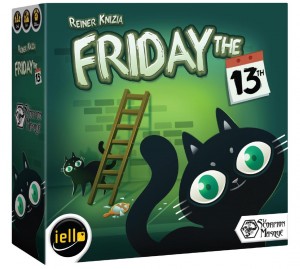Conventions and Expos from a Press Perspective
12 Feb
Posted by David Miller as Card Games, CCGs, Classic Board Games, Electronic Games, Miniatures, Modern Board Games, Other, RPGs, War Games
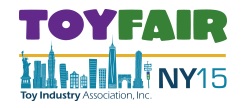 New York Toy Fair begins Saturday and you can expect extensive coverage from Purple Pawn. Watch for reports beginning Sunday and continuing possibly for several weeks.
New York Toy Fair begins Saturday and you can expect extensive coverage from Purple Pawn. Watch for reports beginning Sunday and continuing possibly for several weeks.
With all the great reporting we do from Toy Fair, Gen Con, and other events, I thought though that you, our readers, might also be interested in what it’s like working a convention from a press perspective.
The most important factor in how we cover a major show is time. We typically report from Toy Fair, for example, with two correspondents for 3 days. But that’s still not enough to cover everything. Last year, I saw more than 200 new games (and by that I mean games that were not just new to me but also new to the market) and still I missed a number of companies with which I had hoped to meet. This year’s list of exhibitors showing board or card games includes 169 different companies!
With all that time pressure, meeting game companies at a convention is primarily about getting just enough information to give a quick report on the latest products. Some good examples of reports from last year’s Toy Fair include Goliath, Gamewright, and Wonder Forge. Good Gen Con examples include Mayfair and Catalyst. There are occasions for covering a game in greater depth but convention reporting isn’t one of them.
While in most cases company representatives don’t need a lot of prompting to pitch us their products, I always remind them at the beginning that I’m just interested in what’s new. Otherwise, they might spend a lot of time going over products that aren’t news. Sometimes I also have to remind them that we cover all types and levels of game. Some assume that we only cover games for adults, or teens, or board games (but not card games), or some other subcategory.
In order to keep things moving along, I frequently have to cut a pitch short, decline a demonstration, or say “that’s enough” once I have the highlights. On most of the products, I’m only writing a couple of sentences anyway. Convention articles aren’t reviews, they’re first looks at products just coming on the market (or as often the case at Toy Fair, planned for release later in the year).
Of course, there are games that catch my interest enough to make me pause or even play through a demo. And sometimes I spend a few extra minutes talking to a company representative about business trends or the company’s future plans.
Also, no matter how tight my schedule is, I will always defer to a buyer. It’s a matter of professional courtesy. As important as publicity is to a game company, I understand that sales come first.
Besides the scoop on new products, the secondary benefits of meeting with companies at conventions include establishing a relationship, reminding them to send announcements later in the year, getting background information and news tips, learning about aspects of the industry from those involved, and arranging for review copies.
While we’re on the subject of review copies, the rules of Toy Fair prohibit press from soliciting free products. That’s not a problem for us here at Purple Pawn, as we’re a news site and only do the occasional review. However, I find it rare to meet with a company at Toy Fair and for them not to offer samples. Gen Con is the opposite. There the exhibitors are hit up for free samples by many reviewers, enough that they seem relieved when I don’t ask (which I rarely do).
Toy Fair and Gen Con differ in other ways as well, and in almost every respect, I have to say that Toy Fair is a much better experience from a press perspective than Gen Con. Registration is easier and not limited to one representative. Arranging for lodging is simpler, more flexible, and not appreciably more expensive in Manhattan than it is in Indianapolis. And most importantly, the Toy Fair exhibit hall is huge but not nearly as crowded, and so is much easier to get around than the exhibit hall of Gen Con.
A rule that is the same at both of these shows (and at every other I’ve been to) is that press are not supposed to photograph a booth or products without permission from the exhibitor. In all the meetings at all the shows I’ve attended, only once has my request to take photographs been refused. Unfortunately, I regularly see other people taking photographs without even asking.
One more thing I should address is the issue of appointments. Personally, about half my meetings or booth visits are by appointment. Only a few—Hasbro, Mattel, Lego, and Spin Master—who’s booths are entirely walled off—absolutely require an appointment. For a few more, it’s a very good idea because they can get so busy I wouldn’t catch them otherwise (and it’s only by trial-and-error that I’ve learned who’s likely to fit this category). And in a number of cases, particularly with companies that I haven’t met before, I set up appointments to make a certain impression. It tells the person I’ve made an appointment with that I consider that company important enough to commit time in advance.
So now you have some idea of what it takes to cover an expo as press. By the end of 3 days, my feet are sore and my throat is raw. I’ve written dozens of pages of notes and run through many batteries in my camera. And yet I love it!
For a peak in to Toy Fair from an inventor’s perspective, take a look at Kim Vandenbroucke’s article on the subject from 2011.
Gen Con 2014—Golem Arcana
16 Sep
Posted by David Miller as Miniatures, Modern Board Games, War Games
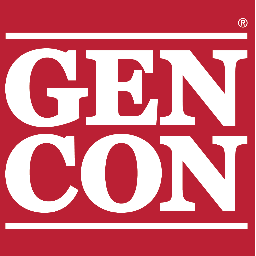 Gen Con provided me an opportunity to take a closer look at Golem Arcana—its system and its figures. As we’ve explained before, with Golem Arcana, Harebrained Schemes provides a sophisticated miniatures game system where all the typical burdens of such games—from tracking the unique abilities and current stats of individual units to generally enforcing the rules—are supported by a mobile app that integrates with the physical components of the game through a Bluetooth-enabled stylus.
Gen Con provided me an opportunity to take a closer look at Golem Arcana—its system and its figures. As we’ve explained before, with Golem Arcana, Harebrained Schemes provides a sophisticated miniatures game system where all the typical burdens of such games—from tracking the unique abilities and current stats of individual units to generally enforcing the rules—are supported by a mobile app that integrates with the physical components of the game through a Bluetooth-enabled stylus.
I didn’t play through a full scenario but I did test the software a bit, and examined the miniatures (if at their size you can call them that). The stylus and mobile app seem to work as advertised. They’re quite easy to use and responsive. It took me but a couple of minutes to become comfortable with the interface.
I was particularly struck by how the system and story are designed to work together. For example, the abilities of a golem figure in battle can vary, depending on which golem knight is controlling it, the blessings and curses bestowed on it by the Ancient Ones, and the relics in its possession. All of these factors are accounted for in the app, which thus makes it possible for players to field a wide variety of units with a limited set of minis.
Software integration also allows Harebrained Schemes to provide a living storyline and flexible scenarios. At the macro level, the company tracks games played and uses the tallied results to determine future developments. At the micro level, a player’s choices and accomplishments in one game will affect future scenarios.
To be honest, I don’t know if making things easier is what gamers really want. The new technology may get them excited, but over the long-run I’m afraid that it’s actually the painting, collecting, and detailed rules that keep them interested. On the other hand, Harebrained Schemes’ implementation of Golem Arcana is certainly impressive. There’s a lot of potential in this game and Harebrained Schemes appears ready to see it through.
 Under the watchful eyes of Bob & Angus, in a demo area thronged by ribbon-seekers, Mayfair Games gave me the lowdown on a variety of recent and upcoming releases.
Under the watchful eyes of Bob & Angus, in a demo area thronged by ribbon-seekers, Mayfair Games gave me the lowdown on a variety of recent and upcoming releases.
Beadpans & Broomsticks, which shipped in June ($35), puts most of the players in the role of old folks trying to escape a retirement home. One player, though, runs the nurses, who try to stop them. Each retiree player gets two tokens, one for the actual patient and one as a decoy.
Villainy (at retail for $50 later this month) is a supers game where the players are up-and-coming bad guys. Starting with petty crimes like putting a kitten in a tree, and working their way up to bigger, nastier plans, such as decaffeinating the world’s coffee, players build skills and recruit henchmen with the ultimate goal of defeating Fantastaman.
Johari is a push-your-luck, set-collection game about buying and selling gems. Counterfeit gems are part of the mix, though players try hard not to get caught selling them.
Catan Collector’s Edition Ancient Egypt (November, $70) builds on Settlers of Catan (obviously) but incorporates the Nile river running through the board. Resources in the game are cattle, papyrus, and stone. With them players collectively build the Great Pyramid. And ten god cards work similarly to the Helpers of Catan scenario, each providing a unique ability to the player who holds it.
Among the games Mayfair has planned for release in 2015 are Extra Extra and Flea Market. The former has players running competing newspapers. They build stories (with a card drafting mechanism), sell adds, and do layout. Somewhere in that mix there’s also supposed to be worker placement and a lot of player interaction. The latter is a quick, silly dice game that has players collecting artifacts, sometimes from the center market and sometimes taking them away from other players.
Participating in Mayfair’s booth was Lookout Games, with whom Mayfair has a distribution arrangement in the United States. Lookout’s Gold Ahoy is a two-player tile-laying game, where the winner is the player with the most gems in a network of connected tunnels. Patchwork is a game about quilting that uses pentomino or Tetris-like pieces with 9×9 player boards. Players try to fill their boards by collecting pieces. Each piece, though, has a time value and a button value. Buttons are victory points but quilting time is limited.
- Comments Off on Gen Con 2014—Mayfair Games
 In addition to three major releases at Gen Con, Paizo also pulled in nine ENnie Awards (including Best Publisher), announced a license to Obsidian Entertainment (Fallout: New Vegas) for electronic games based on Pathfinder (starting with a mobile version of the Pathfinder Adventure Card Game), and hosted nearly 10,000 Pathfinder Society players.
In addition to three major releases at Gen Con, Paizo also pulled in nine ENnie Awards (including Best Publisher), announced a license to Obsidian Entertainment (Fallout: New Vegas) for electronic games based on Pathfinder (starting with a mobile version of the Pathfinder Adventure Card Game), and hosted nearly 10,000 Pathfinder Society players.
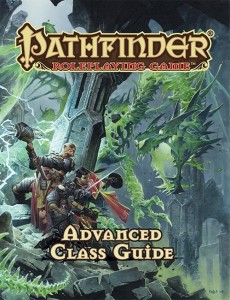 Those releases, by the way, were:
Those releases, by the way, were:
- Pathfinder Roleplaying Game: Advanced Class Guide—featuring ten new character classes, including arcanist, bloodrager, brawler, hunter, investigator, shaman, skald, slayer, swashbuckler, and warpriest.
- Pathfinder Adventure Card Game: Skull & Shackles—which launches players on a series of pirate adventures, includes improved rules, and introduces four new character classes.
- Pathfinder Adventure Path: Iron Gods—a fantasy and technology mash-up, with barbarian, robots, cultists, and crashed spaceships.
Product news aside, Gen Con presented me the opportunity to sit down with Paizo’s publisher, Erik Mona, for a fantastic discussion about growth, diversity, setbacks, and surprises. I invite you to listen. The recording is just under 22 minutes.
Download: Interview-With-Paizos-Eric-Mona-at-Gen-Con-2014.mp3
- Comments Off on Gen Con 2014—An Inteview With Paizo’s Erik Mona
Gen Con 2014—Catalyst Game Labs
24 Aug
Posted by David Miller as Card Games, Miniatures, Modern Board Games, RPGs, War Games
 Catalyst hit the show this year with new products delivered just-in-time for every category. The highlight was Shadowrun: Crossfire, Catalyst’s new deckbuilding card game that’s also cooperative and progressive (meaning progress can be tracked from game to game). Crossfire should be available at retail in September for $60.
Catalyst hit the show this year with new products delivered just-in-time for every category. The highlight was Shadowrun: Crossfire, Catalyst’s new deckbuilding card game that’s also cooperative and progressive (meaning progress can be tracked from game to game). Crossfire should be available at retail in September for $60.
New Shadowrun roleplaying products available at Gen Con included the:
- Beginners Box ($20)—An introductory product with essential rules, dice, a standard adventure, and a 1-on-1 adventure (GM and single player).
- Runner’s Toolkit Alphaware ($60)—A campaign setting in a box with handouts, maps, background information, and job book—designed especially as a next step after the Beginners Box.
- Street Grimoire ($50)—Book of advanced magic.
- Run & Gun ($50)—An advanced combat book.
- Stolen Souls ($45)—A campaign sourcebook for Manhattan.
Gen Con also saw the release of the first Shadowrun novel, Fire & Frost ($15). Five more novels will ship in the next 18 months.
More in the roleplaying category, Catalyst had Beyond the Gravastar ($25), a campaign setting for Cosmic Patrol, and the new Valiant Universe RPG ($40), which applies the Cue System from Cosmic Patrol to the superhero genre.
An advance shipment of the Bravest Warriors Encounters card game made it to the show, though it wont be available in general retail until October. A basic two-player set full of inside jokes from the cartoon sells for $13. By combining red and blue boxes, though, the game can accommodate four players.
For BattleTech, Catalyst finally had the Introductory Box Set ($60) back in print. This is the one with new higher-quality plastic.
Following up on Alpha Strike, the simplified faster-playing BattleTech rule-set that the company launched last Gen Con, this year Catalyst had BattleTech Alpha Strike Companion ($40), a supplement that adds some strategic-level options to the game, and a series of four Lance Boxes ($20), which include two new mechs and two previously released mechs (plus Alpha Strike cards) each. Four additional Lance Boxes will be released in September and October.
In the board game category, Catalyst had two new expansions for The Duke, Siege Engines (5 tiles for $8) and City Troops (12 tiles for $13). The tiles in Siege Engines are red and do not go in the bag. Instead, they’re available in a central pool to both players and can be substituted for certain other tiles already on the board.
Last but not least, Catalyst was previewing two new games tied to the Vikings TV show on the History Channel. The first is simply called History Channel Vikings and is a game of exploration, conquest, and resource management. Available for $60 in March (timed to launch with the new season), the game has a constructable map and sees players crewing a longboat as characters from the show.
The second Vikings game is Jarl ($45), which plays exactly like The Duke but includes new pieces made of an imitation stone instead of wood. In fact, though it won’t be advertised as such (license restrictions, I assume), Jarl can be played in combination with The Duke.
- Comments Off on Gen Con 2014—Catalyst Game Labs
 I’m really glad I took that appointment with Syrinscape. To be honest, I had dismissed the company as just another producer of ambient-sound tracks. But Syrinscape is much more than that.
I’m really glad I took that appointment with Syrinscape. To be honest, I had dismissed the company as just another producer of ambient-sound tracks. But Syrinscape is much more than that.
While other purveyors of background sounds for tabletop gaming offer fixed tracks meant to be played on loop, Syrinscape’s sounds are generated on the fly with tremendous customization potential. The company offers two players, one for fantasy settings and one for science fiction. The Syrinscape Fantasy Player so far includes about 30 sound sets, each with 5-15 sound elements. For example, the flooded cavern set includes “drip”, “toss a rock in”, “passing waterfall”, “distant wind”, “what was that?”, and ten other components.
With Syrinscape’s players, gamers are not only able to make live adjustments to the balance and intensity of sound elements, they can also combine elements from different sets to fit the unique environments of their games.
Players, which can be downloaded for free, come with two sound sets and run on Windows, Mac, iOS, and Android. Additional sound sets can be purchased for $4 each. Another option is the subscription rate, which at $6.50 per month includes permanent access to all new releases, as well as the entire back catalog.
Syrinscape releases new sound sets about once a month. The company is also working with Paizo to release custom sound sets for the Rise of the Runelords Adventure Path, one for each chapter. Several of those are already available and new ones come out every other month.
- Comments Off on Gen Con 2014—Syrinscape
 I didn’t count them myself but Iello’s Matt Bonin told me that the company released 20 games since last Gen Con!
I didn’t count them myself but Iello’s Matt Bonin told me that the company released 20 games since last Gen Con!
Among the newest making their appearance at this year’s show, the most anticipated had to be King of New York. I expect it would have made a bigger splash if Iello had more than just 200 available to sell.
Also designed by Richard Garfield, King of New York borrows a lot from its predecessor, King of Tokyo, yet presents players with a few more interesting choices and alternate strategies. For example, in the new game players must not only consider the risks and rewards of entering Manhattan (which replaces Tokyo) but also a location from among New York’s other four boroughs while outside the city center. In each borough, destroying buildings (achieved with certain dice results) earns a player benefits like victory points, energy, and health, but turns those building tokens in to military units, which may later attack the monsters.
King of New York should be available at retail outlets in September for $50.
Night of the Grand Octopus ($40, available October), which we previewed at Toy Fair, is a bluffing and negotiation game with a Cthulhu-like theme. Players move their cultist figures simultaneously around the board trying to collect ingredients for a summoning. Whenever two or more cultists end up in the same location, the players must agree on who will get the ingredient or all suffer a penalty.
The latest in Iello’s Tales & Games series, The Hare & the Tortoise ($30, available now) has players wagering on the result of a race among five animals. In general, card play advances the animals, but not always in a simple relationship. Depending on the talents of a particular animal too many cards could freeze it (when ahead, the hare may decide to take a nap) or it may move forward even if no cards are played (the tortoise is a slow but steady racer).
Friday the 13th is a new version of Reiner Knizia’s weird trick-taking card game, Poison. The game includes three suits: mirrors, black cats, and ladders. Collected cards are negative points, except for the player with the most of each suit, for whom that suit counts as nothing.
Looking forward, Iello will be distributing in English several games from French publisher Serious Poulp: Steam Torpedo, a two-player game of tactical submarine combat, 8 Masters’ Revenge, a card game of Kung Fu fighting, and 7th Continent, a solo or cooperative game of adventure and exploration.
Also planned for 2015 are The World of Yo-Ho, a board game about animal pirates that uses smartphones as playing pieces, and a game without a title yet, which features cooperative play, deck building, and fighting monsters.
Gen Con 2014 Continues Growth, Becomes Indianapolis’ Largest Convention
19 Aug
Posted by Thomas Deeny as Other
Gen Con LLC released attendance numbers for Gen Con 2014, revealing that this year’s gaming convention is not only the largest of any convention held in Indianapolis, but it has also grown to be the largest (non-electronic) gaming event in the world.
In 2014, Gen Con’s turnstile attendance grew to 184,699 with 56,614 unique attendees. Internationale Speiltage SPIEL (often referred to as “The Essen Game Fair” or “Essen”) had 156,000 turnstile attendance in 2013, which was the trade show’s highest-attended year. Gen Con surpassed this mark that year with a turnstile attendance of 159,364.
Gen Con 2014’s unique attendance numbers are slightly higher than the Future Farmers of America’s last convention in Indianapolis. With FFA’s 2012 convention’s 56,176 attendees, Gen Con had just over 400 more unique attendees. FFA’s 2013 convention, held in Louisville, KY, had 62,998 unique attendees. In 2012, the Future Farmers of America’s last appearance in Indianapolis, they added $38 million into the local economy, compared to Gen Con 2013’s $47 million. The next largest convention in terms of economic impact to the city in 2013 was the FDIC (Fire Department Instructors Conference), with $35 million.
While the actual economic impact of Gen Con 2014 will not be known until later this year, the increase of 14% in growth may reach past the $50 million mark.
This article was edited to clarify that Gen Con has grown to be the largest non-electronic gaming convention.
Gen Con Indy 2014 Exhibit Hall Sells Out in Record Time
20 Dec
Posted by Thomas Deeny as Card Games, CCGs, Miniatures, Modern Board Games, RPGs, War Games
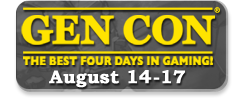 Even with expanding the exhibition space by 14%, Gen Con Indy 2014 has sold out of Exhibit Hall space even faster than the prior year. The 2013 Exhibit Hall sold out of space in mid-February, the earliest the convention had done so. The current waiting list for the 2014 Exhibit Hall is more than 30 companies.
Even with expanding the exhibition space by 14%, Gen Con Indy 2014 has sold out of Exhibit Hall space even faster than the prior year. The 2013 Exhibit Hall sold out of space in mid-February, the earliest the convention had done so. The current waiting list for the 2014 Exhibit Hall is more than 30 companies.
Gen Con Indy 2013 had an approximate 20% increase in convention attendees and a 12% increase in number of exhibitors over 2012. “Gen Con’s back-to-back years of record breaking attendance propelled them into generating $36 million in direct and indirect spending, and $47 million when including ‘induced’ spending,” said Lisa Wallace of Visit Indy, Indianapolis’ convention and tourism agency. Compared to other conventions in Indianapolis, Gen Con Indy has the largest economic impact to the city. While FFA (Future Farmers of America) remains the largest convention in terms of attendees with 55,000 people attending, it will be in Louisville, KY, until returning to Indianapolis in 2016. FFA 2012 added $38 million to the local economy compared to Gen Con Indy 2013’s $47 million. In 2013, the FDIC (Fire Department Instructors Conference) generated an economic impact of $35 million.
- Comments Off on Gen Con Indy 2014 Exhibit Hall Sells Out in Record Time
Gencon LLC Files Chapter 11
19 Feb
Posted by Yehuda Berlinger as Card Games, CCGs, Modern Board Games, RPGs
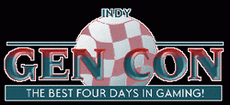 Gen Con LLC, the company behind the popular Gen Con Indy convention, filed for bankruptcy on Friday. According to the press release distributed by the company, the bankruptcy will not affect any of Gen Con’s currently scheduled events. The press release is not specific, noting only that the bankruptcy is related to “attempts to expand its core business to encompass externally licensed events,” but there has been some speculation that the bankruptcy is related to the lawsuit recently filed against Gen Con by Lucasfilm. Given the company’s own explanation, this interpretation seems entirely reasonable.
Gen Con LLC, the company behind the popular Gen Con Indy convention, filed for bankruptcy on Friday. According to the press release distributed by the company, the bankruptcy will not affect any of Gen Con’s currently scheduled events. The press release is not specific, noting only that the bankruptcy is related to “attempts to expand its core business to encompass externally licensed events,” but there has been some speculation that the bankruptcy is related to the lawsuit recently filed against Gen Con by Lucasfilm. Given the company’s own explanation, this interpretation seems entirely reasonable.
- Comments Off on Gencon LLC Files Chapter 11
Trending
- Are Board Games Dangerous?
- Home
- Sequence Game, and Variants
- The 20 Most Valuable Vintage Board Games
- Oh the Irony—Illuminati Card Game Continues to Inspire Conspiracy Theorists
- Dora the Explorer Games
- The Truth About Dominoes On Sunday in Alabama
- Newton's Apples, a Gravity Strategy Game
- Sid the Science Kid
- Hasbro and Mattel Merger?
Archives
Most Popular Articles
- The 20 Most Valuable Vintage Board Games
- Sequence Game, and Variants
- USPS Adds Board Game Flat Rate Box
- Baila, the Estonian Drinking Card Game
- The 13 Most Popular Dice Games
- The Truth About Dominoes On Sunday in Alabama
- Are Board Games Dangerous?
- Oh the Irony—Illuminati Card Game Continues to Inspire Conspiracy Theorists
- The Convoluted Story of Iron Wind Metals, Ral Partha, and Battletech Miniatures
- Guess Who? The Naked Version
Recent Posts
- Toy Fair 2019—Breaking Games
- Talisman Kingdom Hearts Edition
- Toy Fair 2019—Winning Moves
- Toy Fair 2019—Games Workshop
- Toy Fair 2019—Star Wars Lightsaber Academy
- Toy Fair 2019—Stranger Things Games
- Toy Fair 2019—HABA
- Licensing Roundup
- Game Bandit
- 2018 A Difficult Year For Hasbro But Not For D&D Or MtG
Recent Comments
- on Toy Fair 2019—Winning Moves
- on Game Bandit
- on Second Look—Dungeons & Dragons Waterdeep Dragon Heist
- on Crowdfunding Highlights
- on Beyblade SlingShock
- on Game Bandit
- on Game Bandit
- on Watch This Game!, the Board Game Review Board Game
- on Second Look—Vampire: The Masquerade 5th Edition
- on Palladium Books Loses Robotech IP License, Cancels Five-Year-Overdue Robotech RPG Tactics Kickstarter

